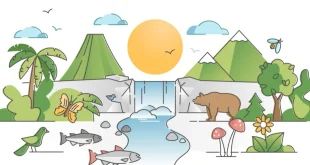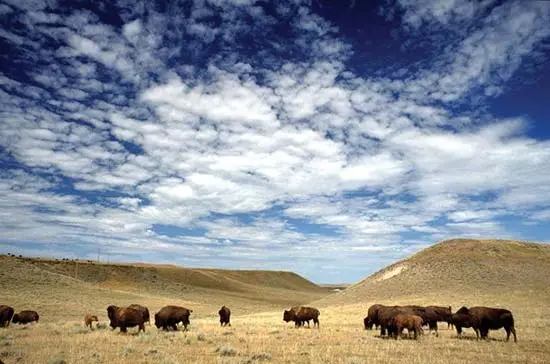
Rangelands
Rangelands are a lively landscape, comprised of many resources, which produce many products. The rangeland landscape and its properties are constantly being adapted by a collection of non-human forces, including fire, climate, grazing, or weather.
Humans also adjust rangelands directly through development projects such as mining, energy, transportation, communications infrastructure, and recreation. People also affect the other forces of change by introducing exotic and invasive species, controlling or burning fires, grazing management, and potentially impacting the weather and climate patterns through human-made changes in the chemistry of the atmosphere.
People who manage rangelands need to find ways to predict how management practices or natural disturbances will impact the rangeland vegetation, so they can develop state and transition models.
These models are box-and-arrow figures used to define vegetation change, or plant succession, from a precise disturbance based on the existing vegetation community, the climate, and the soil of a site.
Rangelands Resources
Rangelands are energetic ecosystems that produce a wide diversity of services and goods looked for by society, including wildlife habitat, livestock forage, mineral resources, water, wood products, open space, wildland recreation, and natural beauty. To continue to provide those goods and services, rangelands need to function ecologically, besides that, they must be able to capture nutrients and water and convert them into plants.
How Rangelands Changes
The vegetation in rangeland is always changing toward one or several plant communities. By understanding why vegetation changes and how to deploy that change is serious for rangeland managers to make sure that rangelands continue to offer the goods and services desired by the communities.
Research about changes in plant communities, succession, on rangelands, give rise to a belief that vegetation change was linear. That means when community A changed into community B, which eventually changed into community C, and so on. After many decades, rangeland managers and scientists understood that vegetation change is not always linear.
Management changes didn’t always bring back the desired plant community. Normal disturbances often led to new plant communities that were minimally influenced by management. The impact of disturbance and management on plant communities varied based on intervention type and intensity.
The management actions applied, with their frequency, intensity, and duration, determine the development of precise plant communities and how those management actions interrelate with environmental conditions and their changes over time.
Classifying Rangelands
There are no clear limitations to ultimately classify rangelands. Grouping plant species into vegetation types helps managers assess ecological status and plant community trends. Based on major plant species, further division of vegetation types into groups occurs. For example, plant associations such as salt-desert shrub, sagebrush steppe, intermountain bunchgrass, juniper woodland, tallgrass prairie, and shortgrass prairie exist.
Managers use land classification systems like vegetation types, ecological sites, and habitat categories for policy and research.
Ecological Sites
An ecological site is a kind of rangeland that has a firm potential to yield a distinct plant community .It defines units of land that need a unique management strategy based on the climate, kind of soil, and topography found on the site. Currently, the most extensively accepted classification system for rangelands is the Ecological Site.
What is an Ecological Site?
An ecological site is an identifiable, unique, and repeatable area of soil and vegetation on a landscape. Each ecological site is a result of the environmental factors that affect the development of the vegetation and soil, including disturbance regimes. It has specific similar physical, biological, and chemical characteristics and has the ability to produce a separate mix of plant species with similar amounts of annual vegetation biomass.
The basic principle is that a specific soil type based on texture, depth, horizonation, pH, water-holding capacity, salinity, and other factors is occupied by specific plant species. The soil, therefore, is the basis of an ecological site. If the foundation undergoes a drastic change, the structure above will have a consistent change.
Ecological sites form the basic classification unit for classifying different plant communities and their associated soils on rangelands. A major concept for an ecological site is the Potential Natural Community (PNC). It is a complex concept that includes the typical disturbance management that affects the ecological site.
What is an Ecological Site Description?
Soil scientists and range management specialists designate distinct components for each ecological site. The complete accumulation of these components into one document makes an Ecological Site Description (ESD). Ecological site descriptions aim to clearly depict the structures that make the site unique from other ecological sites.
The arrangement for ecological site descriptions changes with time because researchers and managers regularly create new knowledge about the environmental changes and ecological processes that affect the development of distinct soils and their related PNC.
Important environmental and ecological components of an updated ecological site description are;
- The major land resource area in which the ecological site is located
- Climatic features
- Physiographic features
- Inducing water features
- Typical soil features and
- Plant communities
Except for the major land resource area, the ESD will provide considerable details for each parameter. An ESD intends to provide managers and landowners with the ecological and environmental information they need to develop management goals, management plans, and actions for the rangelands they manage. The content of an ESD provides the users with much of the information they need to comprehend the potential productive capability of the rangeland, the limitations that limit management options, and the potential hazards that may occur.
How to Develop Ecological Site Descriptions?
These are used to make decisions about how to manage rangelands. Information and Data about ecological sites are combined with other resource information to improve decisions. One of the key steps is to identify and map the ecological sites and soils on a varied landscape. Managers can measure the seral communities’ annual production and vegetative composition against the potential plant communities that might occupy the site after mapping the soils and ecological sites.
How are Ecological Site Descriptions Used?
Ecological sites, diverse soil-vegetation units, share management issues across landscapes. Researchers can examine interrelations among ecological sites at different spatial scales and apply the results at the scale suitable for addressing management questions and issues. Scientists defined six uses of ecological site descriptions:
- Describing the interactions among vegetation, soils, and land management
- A basis to measure the condition of current resources and monitor changes
- An outline to assess management opportunities and predict the consequence of management decisions
- A context for the identification of knowledge gaps in vegetation aspects
- A communal framework to communicate the resource information among disciplines, organizations, and agencies, and
- A framework for shifting experience and knowledge.
Rangeland Vegetation Types
The main types of rangelands around the globe are grasslands, shrublands, desert savanna forests, woodlands, and tundra. Different rangeland types support diverse plant associations, influenced by soil, climate, and humans, hosting a variety of biota. When planning management activities, one must consider the rangeland type, as they differ in soil, precipitation patterns, and terrain. Therefore, management practices that work fine in one rangeland type may be inappropriate for another.
Grasslands
Plants of the family Gramineae commonly dominate grasslands and they are almost free of woody plants. They are the most fruitful rangelands in the world for providing fodder for wild and domestic animals. Areas that receive annual rainfall between 250 to 900 mm generally have grasslands. These circumstances support grasses, whose fibrous roots can effectively collect moisture from the soil surface.
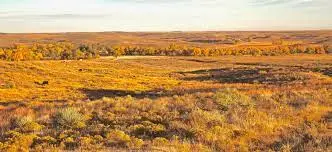
Desert Shrublands
The driest of the world’s rangelands are desert shrublands, usually receiving annual precipitation of less than 250 mm. The rainfall in desert shrublands differs greatly from year to year, occurring as occasional, high-intensity rains in less than 90 days. As a result, the content of water in the soil surface is very dry for much of the year and can’t reach the short fibrous roots of grass plants.
Shrubs with long tap roots thrive in these conditions as they can draw moisture from deeper within the soil. Desert shrubs typically space themselves farther apart, allowing their roots to spread and collect water over a large area. To know about biomes in the world in more detail you can access to https://thecliment.com/uncovering-the-beauty-of-earths-major-biomes/
Savanna Woodlands
Savanna woodlands have a prolific herbaceous underwood dominated by low-growing trees, scattered, less than 12 metres tall. Characteristically, savanna woodlands happen as a conversion zone between forests and grassland and can shift toward either phase conditional on grazing pressure, logging, fire control, and drought.
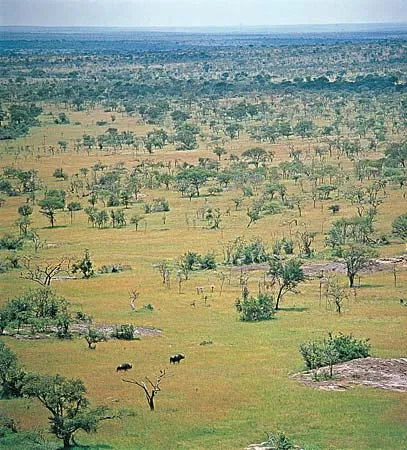
Forests
The densely spaced, taller trees of forests stop the development of herbaceous underwood with any grazing value. Forests usually occur in high-rainfall areas of more than 500 mm because of the superior amount of moisture needed for the sustenance of the biomass of a forest. High rainfall causes considerable leaching of soil nutrients; therefore, forest soils are usually low in fertility. Thinning forests through fire or logging can open the canopy and create areas of valued forage for wildlife and livestock.
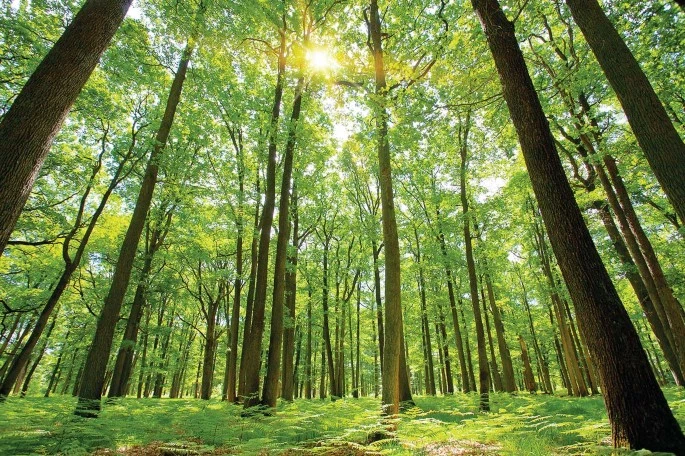
Tundra
Tundra is a treeless plain in high-elevation regions or the Arctic that covers about 5% of the earth’s surface. The tremendously cold climate keeps tundra ice-covered for more than seven months of the year, and the permafrost confines tree growth. Arctic tundra can be found in Greenland, North America, northern Asia, and northern Europe.
Vegetation on the tundra comprises primarily of low-growing, lichens and tufted perennial plants. Low rainfall of 250 mm to 500 mm and strong winds make the tundra an unwelcoming place for most plant life. Tundra is infrequently used to graze livestock because of its uneven terrain and short grazing season of less than 90 days. However, the country of Peru is an exception, where the alpine tundra is used broadly by llamas and alpacas.
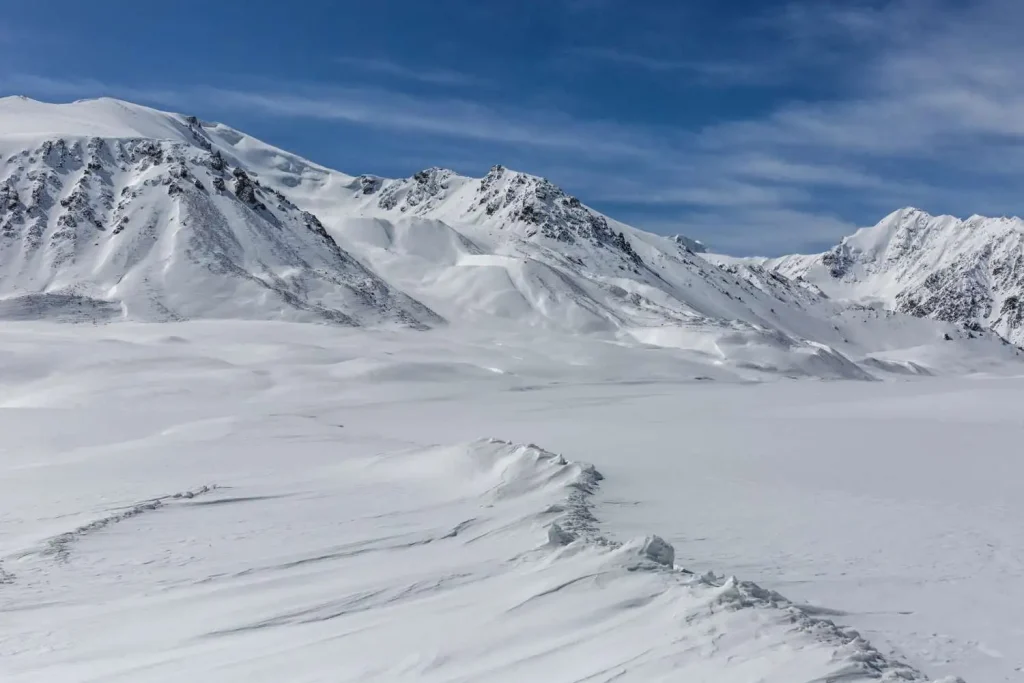
Climate & Drought in Rangelands
Rangelands worldwide are firmly attached to regional and local climates, benefitting from periods of higher rainfalls and suffering during extended drought periods. Climate inconsistency and change pose exceptional tasks to livestock producers, land managers, and pastoralists the world over.
An increased understanding of large-scale methods of climate variability has improved seasonal forecasts and can support rangeland drought planning and preparedness efforts, helping to withstand production processes and guide land stewardship.
A changing climate ever changing towards warmer conditions and increasing hydroclimatic inconsistency is further raising the risks of becoming climate-smart in using climate monitoring and forecast information in managing rangelands.
Fire in Rangelands
With the growing recognition of the important ecological role played by fire, there has been a corresponding increase in the debate over how to respond to wildfires and when to use prescribed fires as a management tool. Some people are concerned that fire is being seen as a cure-all and may be used without proper consideration. However, others argue that when used appropriately, prescribed fires can successfully achieve management goals. A video presentation on what are rangeland can be viewed from https://www.youtube.com/watch?v=xWznUuUcMTc
 The Climent Respect your roots, Protect your planet
The Climent Respect your roots, Protect your planet
